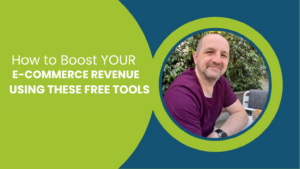
Building a successful e-commerce store can feel overwhelming, especially when you’re trying to grow your revenue quickly on a budget. The good news? There are several free tools out there that can help you accelerate your e-commerce growth without spending a dime. In this blog post, we’ll dive into five free tools that can help you increase your online revenue while providing you with valuable insights and strategies used by successful e-commerce businesses.
1. Social Media Posting: Build a Strong Community
The first free tool you can leverage is social media. If you own an e-commerce store, chances are you already have some form of social media presence. Whether it’s Facebook, Instagram, or Twitter, posting regularly on these platforms is a free way to engage with your audience and share your content.
However, it’s not enough to simply post content. Many e-commerce businesses make the mistake of focusing solely on selling products—relying too heavily on posts that say “Buy our product!” over and over. The key is to engage with your community and share valuable, non-sales content. Respond to comments, join or create groups, and add value to conversations. By building relationships and engaging authentically, you’ll increase your chances of turning followers into loyal customers.
When crafting your social media strategy, always ask yourself: What’s your “why”? Is it just about making money, or are you offering something that makes a difference? For example, if your e-commerce store specialises in sustainable products, your “why” could be to help the planet while offering cost-effective, reusable solutions. People are more likely to connect with a brand that has a clear purpose and story behind it.
2. Google Analytics: Track and Improve Performance
Next on our list of free tools is Google Analytics. As a business owner, you need to know how your website is performing and where your traffic is coming from. Google Analytics provides valuable insights into your audience, including their behaviour, location, and devices they use to shop.
By understanding these metrics, you can make informed decisions to improve your website’s user experience and conversion rates. You can track which pages are the most popular, identify where visitors drop off, and optimize your product pages for better results.
Furthermore, Google Analytics can also help you monitor the effectiveness of your marketing campaigns, allowing you to make adjustments that maximize your ROI.
3. Google My Business: Boost Local SEO
For e-commerce stores that operate in specific regions or have a physical location, Google My Business (GMB) is an essential free tool. By creating and optimizing your GMB profile, you increase your chances of appearing in local search results and Google Maps when potential customers are searching for products or services in your area.
With GMB, you can manage your business profile, respond to reviews, post updates, and share relevant photos and information. These actions can boost your visibility and improve your local SEO, which can ultimately drive more traffic to your website and increase your revenue.
Popular eCommerce Marketing Videos
Popular eCommerce Marketing Videos
05:15
22:36
06:29
4. Canva: Create Engaging Visuals
Creating eye-catching and engaging visuals is crucial in the e-commerce world, and Canva is one of the best free tools for the job. This user-friendly design platform allows you to create high-quality graphics for social media, product listings, ads, and more—all without needing any design experience.
Canva offers templates that are tailored to different platforms like Instagram, Facebook, and Pinterest, ensuring your content looks professional and optimized for each. Whether you’re designing promotional banners, Instagram stories, or email newsletters, Canva’s free version provides more than enough resources to get started.
5. Mailchimp: Build and Nurture Your Email List
Lastly, we recommend Mailchimp as a free tool to help you grow and nurture your email list. Email marketing is one of the most effective ways to boost your e-commerce revenue, and Mailchimp provides a robust platform for sending newsletters, product updates, promotions, and more.
With Mailchimp’s free plan, you can manage up to 500 subscribers and send up to 3,500 emails per month, making it a cost-effective way to stay in touch with your audience. The platform also offers automation features, so you can send personalized emails to subscribers based on their behaviour and preferences.
Conclusion: Growth Without Breaking the Bank
There’s no shortage of free tools that can help you grow your e-commerce revenue. Whether it’s social media engagement, tracking performance with Google Analytics, optimizing your local SEO with Google My Business, creating compelling visuals with Canva, or nurturing your email list with Mailchimp, all these tools are easily accessible and can make a huge impact on your business.
The key takeaway is that growing an e-commerce store doesn’t have to involve spending a fortune on paid ads and fancy tools. With consistent effort and the right strategies, you can use these free resources to build a loyal customer base, increase your visibility, and ultimately boost your revenue.
What free tools are you using to grow your e-commerce business? Share your thoughts in the comments below!







